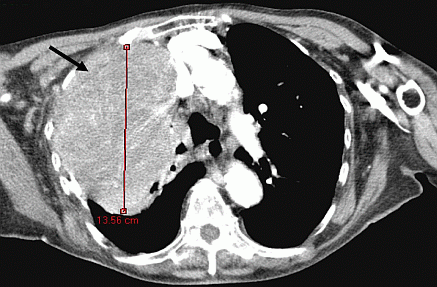ICEECE2012 Poster Presentations Clinical case reports - Thyroid/Others (81 abstracts)
A case of refractory hypoglycemia
J. Wang , D. Singh , A. Jayashekara , S. Ellis & F. Kaplan
Lister Hospital, Stevenage, UK.
A 74-year-old diabetic lady presented to emergency-department following a collapse due to hypoglycaemia (blood glucose 1.7 mmol/l) and responded dramatically to intravenous–glucose. She had recurrent hypoglycaemic episodes in the last-fortnight, despite discontinuation of her oral hypoglycaemics and no other obvious precipitating factors/toxins like alcohol. She was on prednisolone, 10 mg along with azathioprine, 150 mg, atenolol, 25 mg, and candesartan, 8 mg. She has rheumatoid-arthritis, skin-psoriasis and essential-hypertension. She was diagnosed with a large right sided intra-thoracic fibrosarcoma (Fig. 1) for which she underwent surgery in 1995 and was confirmed histologically. Subsequently, she had further recurrence which deemed inoperable. These hypoglycaemic-episodes were investigated by ruling-out any obvious cardiac, renal, hepatic, or adrenal-dysfunction or sepsis. Perhaps coexistent fibrosarcoma and recurrent hypoglycaemia pointed towards possibility of non-islet cell tumour-hypoglycaemia. She was managed initially with i.v./oral-glucose and high-dose prednisolone along with carbohydrate rich diet; without controlling her hypoglycaemic attacks. Diazoxide, which inhibits pancreatic insulin-release, was introduced at a low-dose and up titrated to 150 mg TDS. Hypoglycaemia are usually fully-reversible after surgical removal of tumours; however, in our case with an inoperable-tumour, alleviating hypoglycaemia was becoming a therapeutic challenge. With limited options available, the role of GH was considered; as it is well established that GH stimulates hepatic gluconeogenesis and glycogenolysis, probably suggesting a role in managing non-islet cell tumour hypoglycaemia. She was thereby treated with GH which reduced frequency of her hypoglycaemic episodes and rendered her near-euglycemic.
Conclusion: Hypoglycaemia being a common reversible medical-emergency is frequently associated with oral hypoglycaemic-agents/insulin-therapy; however, it can rarely be a paraneoplastic manifestation of underlying tumour. Our case report illustrates therapeutic challenges encountered in a patient with inoperable fibrosarcoma, presenting with resistant hypoglycaemia and perhaps suggesting role of GH in similar cases.

Figure 1 Transverse view of CT-scan thorax with a large rightsided mass (fibrosarcoma on histological-examination) seen in the upper-zone of the lung.
Declaration of interest: The authors declare that there is no conflict of interest that could be perceived as prejudicing the impartiality of the research project.
Funding: This research did not receive any specific grant from any funding agency in the public, commercial or not-for-profit sector.




